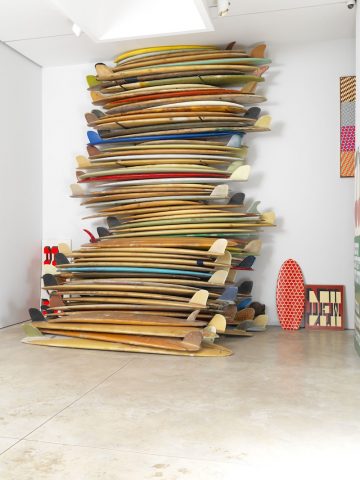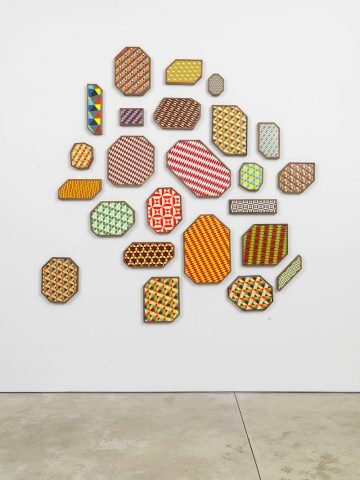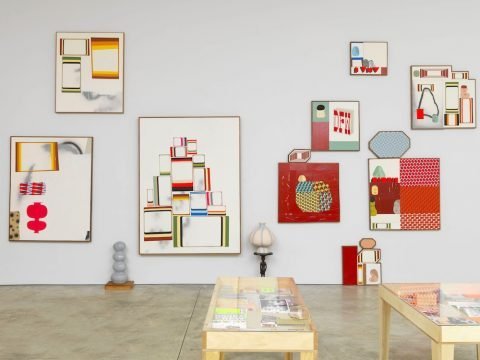Barry McGee: ‘I still have that in me, but I’m older now’ (an interview)
Raised in San Francisco, his hometown and main source of inspiration, Barry McGee turned 52 this year. He is one of the few artists from the ‘beautiful losers’ wave who has survived the official art market. We met him in occasion of his current solo show at Cheim and Read.
- Installation view of Barry McGee at Cheim & Read, January 4 – February 17, 2018. Courtesy Cheim & Read, New York. Ph. Brian Buckley.
- Installation view of Barry McGee at Cheim & Read, January 4 – February 17, 2018. Courtesy Cheim & Read, New York. Ph. Brian Buckley.
- Installation view of Barry McGee at Cheim & Read, January 4 – February 17, 2018. Courtesy Cheim & Read, New York. Ph. Brian Buckley.
- Installation view of Barry McGee at Cheim & Read, January 4 – February 17, 2018. Courtesy Cheim & Read, New York. Ph. Brian Buckley.
A Bay Area artist, who first established his reputation tagging the streets of San Francisco—that is becoming a new art scene hot spot—, Barry McGee graduated from the city’s celebrated Art Institute before making a big splash on the international art scene. Debuting his paintings and drawings populated with hobos and misfits and patterned with bold, graphic designs in New York in the mid-‘90s, McGee went on to exhibit with Deitch Projects before migrating to Cheim & Read. Conceptual Fine Arts recently spoke with the artist in his San Francisco studio about his second show with the gallery.
When did you start making art?
I’ve been making it continuously since I was a kid.
And working on the streets?
I was in high school, around 16 or 17. I had a couple of loser friends. We weren’t in with the in-set at all. We were on the fringe. It was our only way of making art. It’s the outcasts—all of the straggly kids—that figure out how to work the system. I had some other friends who were into the nightlife in San Francisco and they said you’ve got to start tagging.
What did you learn to do at the San Francisco Art Institute that differed from what you were already doing on the street?
I didn’t really combine those two worlds. Before I went to the Art Institute I was going to a community college, taking figure drawing classes and whatnot. They had a transfer program so when I got to SFAI I just wanted to absorb as much traditional art at the time. I knew what I was doing—actually I didn’t know what I was doing on the street at that time, but I kept those two worlds separate.
Do you consider yourself a street artist?
No, I used to just do graffiti. I never felt that there was any art to it. I like the non-artfulness of it. It’s generally quite different than what you find with all of the trappings of the art world. It’s a really separate universe.
Do you still tag outdoors?
I did the other night, but it was a special opportunity so I took advantage of it. It’s hard to explain cause it’s really automatic for me. It’s like a hand memory. It feels really good to do, especially when I’m tagging abrasive things in a pedestrian manner. No one would ever know that I did it. It’s really anonymous.
Do you feel like you capture the beat of the city in your studio?
It depends on what kind of day I’m having. Sometimes I don’t want to capture any aspect of the city in the studio. There are so many different emotions and feelings that I bring into the studio on any given day. Sometimes I want to do just one certain type of thing, but there are other days when I just want to spray paint things outside to make it go faster. There’s still the need to get something out there in a quicker way that’s stuck inside me—something in a faster way than the art channel works.
Does your work change from the time it leaves the studio to the time we see it in a gallery or museum exhibition?
Yes, very much so. I never know how it’s all going to hang together. I like that pressure, where it could either be a flop or a success— for whatever being successful means. I bring all of the elements there and then I’ll see if I can pull it off.
Is your process to make the elements and then assemble them or is the work all planned out, made and then assembled?
It’s really loose. I have certain areas that I know how I want them to work, but the process is to bring it all together when assembling the elements on site.
Do you respond to the architecture of the space?
Yeah, for sure, I’m really into hiding things right now—just having things in the room, but not really seen. I have no idea why. It makes no sense, but I like to have other presences there.
How did you come up with your unusual technique of clustering images together?
Even though I’ve been trying to step back from that way of working, things are starting to get clustered again. I think it somehow works better with my thought process. A lot of the things that get clustered together are extraneous things—photographs, drawings and found things—that I like. They’re little moments that come together to make a bigger whole, but it doesn’t always work.
What’s in the mix for this show?
There’s drawing, painting and sculpture. And there are some banners, some surf boards and some paintings on old messed up canvases. I’m also showing some other people’s art—kind of like a group show within the show. That’s something I like doing. I don’t need so much space for myself. I’m into the sharing economy.
What’s your attraction to bold, graphic patterns?
Man, I love those. I don’t know why. I love anything bold and graphic, not just patterns. Everything I’ve ever been into had a big, corresponding bold graphic with it.
And what about hobos and misfits? What do they convey in your work?
We have a huge homeless situation in San Francisco, as you may know. It works into my work somehow—through osmosis.
Are you showing any embellished objects or mechanized mannequins this time around?
There’s a mechanized something—and there may be others that are hidden.
Are any installations or interventions in the space?
Yes, there are some changes to the space. I wasn’t sure if the gallery would let me do them—or if I even want to do them. In San Francisco you can get away with doing almost anything, but I find New York to be a more polished, clean white gallery situation. Sometimes I feel like I should work with it and sometimes I feel like working against it.
How do you collect the material for your installations?
I’m always collecting things. I just found the most amazing piece of wood. It looks like someone punched a door. I have it in my car right now. It’s red, and where the hole is busted through it’s beige-white. It looks like a Japanese action painting.
Did you find it on the street?
Yeah, I found it in a big pile of garbage. I had just dropped my daughter off and almost skidded and caused an accident when I saw that piece.
What impact did growing up in the Reagan years have on your outlook and work?
Oh, I would kill for Reagan right now. We thought it was bad back then. The Reagan-Bush years were a street dynamic find. There were a lot of things going on and there were a lot of protests. Not that it’s any different now. I still have that in me, but I’m older now.
Has a response to life under Trump filtered into your work?
I hope it doesn’t, because I don’t want anyone of that ilk to have that much sway. There are definitely disparaging messages I would put out on the street that would fall into that category, but I’m trying to keep those statements pedestrian, where anyone might have done it.
What does the American Dream represent to you?
Hmm, probably freedom—it’s the freedom to not be an asshole and fuck other people over, in the most basic sense. That’s why I like graffiti. It has some of those elements. It has a light rebellion to it—a kind of freedom to it—but then it really pisses off a lot of people, too. Art also has some of those feelings, too, in a more mannered way. That’s a question I need to think about. What are we trying to achieve here anymore?
I think we all used to believe it was the same thing.
I thought we were marching forward—everyone on this planet was marching forward and we were all trying to make a better thing happen here. Then, as we’ve discovered, we’re marching backwards now. Not me, but there are elements that want to go back. How did that happen? We all listen to the same music.
Well, some people listen to country.
I understand that, but we all went through these things together and now it seems weird that we’re marching backwards—a full turnaround, marching backwards over a cliff.
You’re quoted as saying “I’m not a sweet person. I’m OCD, ADD, but DFW and say thank you obsessively.” Do you remember the context for it?
I don’t, but it sounds like something I would say, for sure—in a nervous rant. There’s a little bit of truth in everything.
Are you still that way now?
I’m a little less Down for Whatever, DFW. I’m still OCD. Yeah, it depends on the situation. I could still be down for whatever—if the shit hits the fan. In San Francisco I feel like everyone has the playbook ready. I’ve seen people gather quickly here. They know how to cause a ruckus when it’s time. There’s an internal, unsaid playbook, which is comforting. It’s understood.
Are you concerned with having street cred or are you way beyond that now?
I don’t worry about that kind of stuff anymore. I’ve sold out so many times—in so many people’s eyes and my own eyes. I often make sacrifices just to keep this whole thing going. I do the listing that I don’t want to do and pretend like it didn’t happen, which is impossible in this day and age. It will get smeared all over the Internet.
What does your work tell us about San Francisco?
There’s a certain thing about the Bay Area, but I’m not quite sure exactly what it is. It’s kind of dirty, kind of broken. They’re parts of it, obviously, which are very high tech and moving forward in that direction. It’s basically the whole mess of it that makes it work.
And do you feel that you work speaks to the world at large?
On a good day I hope it would. I know that some things on the street, when done in the right way, get the job done; but when things go into a commercial gallery there’s a whole other set of rules, which has something to do with ownership and exchange of money, and things like that.
Which goes back to Grimm’s fairy tales.
You’re right! It does, and all of our favorite people are in there—the same outcasts and fringe elements. These people are all in the art world that we love, too. It’s all we have. There’s nothing bad that I can say about it at all. I just want to invite more people to it—with open arms and a big hug.
February 6, 2018




